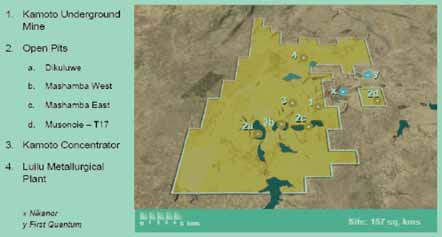While the huge greenfield Tenke Fungurume
copper project in the Democratic
Republic of Congo has been center stage
for some time, the brownfield Kamoto project
in the Kolwezi district, about 220 km
northwest of Lubumbashi, has also been
attracting attention lately as the Kamoto
Joint Venture is close to starting refined
metal production.
Key mine components were ordered a
year ago, the construction team build-up
began in January 2007, and extraction
commenced at the Kamoto underground
and T17 open-pit mines in April. The 7.5-
million-mt/y-capacity concentrator restarted
in July and commissioning of the Luilu metallurgical
plant got under way in September.
Copper and cobalt output should
start in the final quarter of 2007. Total
reserves and resources (excluding inferred)
are stated as 162 million mt at 3.5% copper
and 0.38% cobalt, sufficient to support
a mine life of at least 40 years at anticipated
production rates. The average site cash
costs, net of cobalt credits, are estimated at
$0.20/lb copper, placing Kamoto close to
the lower end of the global mine cost curve.
The Kamoto/Dima mining complex is
one of a number of substantial copper
operations that state-owned Gécamines
was obliged to close. It comprises the
Kamoto underground mine; the Dikuluwe,
Mashamba East, Mashamba West and
Musonoie-T17 oxide open pits; the Kamoto
concentrator and the Luilu metallurgical
plant as well as the related mineral properties.
As the region’s political situation improved
Gécamines sought to refurbish and
rehabilitate the facilities, signing the
Kamoto Joint Venture Agreement with
Kinross-Forrest Ltd (KFL) to hold, redevelop,
rehabilitate and operate the Kamoto JV
Assets. The Kamoto JV received the
approval of the Conseil des Ministres du
Government de Transition of the DRC (the
Congolese Government) on July 15, 2005.
The JV required that a feasibility study
be delivered by KFL to Gécamines within
eight months after the Kamoto JV has
received all required regulatory approvals.
This feasibility study, delivered in April
2006, projected a discounted rate of return
on total capital invested to achieve a minimum
of 150,000 mt of sulphide ore
processed each month of not less than
20%. As per the JV terms, this enabled KFL
and Gécamines to establish a DRC company
to hold the Kamoto JV Assets. This is the
Kamoto Copper Co. (KCC), initially 75%
owned by KFL and 25% by Gécamines.
KCC has a service agreement with Kamoto
Operating Ltd. (KOL) whereby KOL purchases
the equipment and materials for the
project and was also to market and sell the
production. Subsequently, Bermuda-based
Katanga Mining Ltd. acquired KFL in
stages, completing the deal and listing on
the Toronto Stock Exchange in July 2006.
Katanga Mining, headed by Arthur
Ditto, former president of Kinross Gold
Corp., has offices in London, England.
Katanga reports that capital investment in
Phase 1 of the project, to first production,
is $172 million. Phase 2, covering bringing
roaster 1 online through 2008-2009 will
require $97 million, and Phase 3, involving
a second roaster and a dewatering program,
will absorb $105 million. The final phase,
costing $50 million, will take the operation
to full rate production of 150,000 mt copper
and 8,000 mt cobalt in 2011.
At the Kamoto underground mine, twin
6.5 x 6-m ramp declines provide access for
trackless mining equipment and the shaft
system can hoist 11,000 mt/d. Katanga
Mining ordered a fleet of drilling, bolting,
loading and haulage machines from Atlas
Copco, including four Rocket Boomer 282
drifting rigs, four Boltec H235 machines,
four Scooptram ST1520 LHDs and six
Minetruck MT5010 haulers.
Work on the concentrator has involved
South Africa’s Multotec in refurbishing the
flotation plant. First, Multotec Zambia completed
a detailed plant audit at the concentrator,
making recommendations to the
project manager Hatch as to how the rehabilitation
should be carried out. The resulting
supply contract included design of the
level control system and delivery of the wetted
parts of the new flotation mechanisms.
A field service team assembled a prototype
of the Wemco 120 unit in the concentrator
to assist KOL personnel in setting up the
rehabilitation process and later a Multotec
commissioning team worked with operational
and engineering personnel from the
concentrator. Multotec will also train plant
personnel on general inspection and maintenance
issues on the flotation cells.

However, the target firm decided to
review the strategic options open to it and in
early October, having completed the review,
Katanga Mining announced it had signed a
term sheet for a $150-million one-year loan
facility with Glencore International AG. The
loan bears interest at LIBOR plus 4%
payable upon maturity. During the one-year
term, the loan is convertible at the option of
Glencore into 9,157,509 (fixed number)
common shares of the company. Katanga
has the right to repay the loan at any time.
The agreement also includes a ten-year offtake
contract with Glencore for all the copper
and cobalt production.
As featured in Womp 07 Vol 8 - www.womp-int.com

